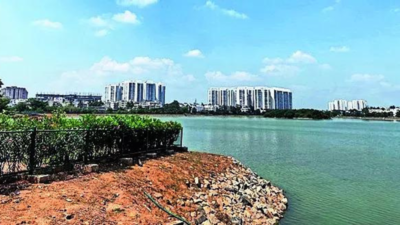9 Bengaluru citizens revive dying Sarakki lake, turning sewage-choked waterbody into thriving ecosystem | Bengaluru News

BENGALURU: A lake doesn’t vanish overnight — it disappears in slow motion. The water turns murky, fish die, birds leave, and finally, the land is claimed, concreted, or forgotten.Sarakki Lake in JP Nagar was heading in that direction since over a decade. However, a different story unfolded for the 92-acre lake was choked by sewage, weeds, and encroachments — the one led by nine determined citizens, who took on apathy and ecological collapse and revived the lake.In 2012, Prof KS Bhat, Hariprasad Y, Ramachandra Joisa, Manjunath MP, Sudarshan G, Manish A, KR Sooryanarayana, Shankar Sastry, and Srivatsan — most of them retired professionals — formed the Sarakki Lake Area Improvement Trust (SLAIT). Their journey began with getting the lake mapped by the survey department, confirming its size as 92 acres and 20 guntas, and identifying nearly 200 encroachments. In 2013, they filed a PIL, resulting in an eviction drive that cleared illegal structures under police protection. After being passed between departments, the lake finally came under BBMP’s custody in 2019.SLAIT managing trustee KS Bhat said sewage inflow was their biggest challenge: “Untreated wastewater flowed through multiple channels — virtually like five small rivers. Tackling this required coordination with the BWSSB, which took over two years.” With BWSSB’s help, a sewage treatment plant was set up in 2020. Desilting followed, with guidance from IISc experts. The Centre, through Atal Mission for Rejuvenation and Urban Transformation (AMRUT) enabled construction of diversion pipelines to cut off toxic waste. The lake’s transformation brought visible results — air quality improved, and local temperatures dropped by nearly 2°C. The fisheries department stocked the lake with native species like fish, crabs, prawns, and turtles. Today, over 200kg of fish are harvested daily and sold through govt channels. SLAIT also planted over 2,500 trees, creating a self-sustaining ecosystem.The lake now supports water security for nearly 2 lakh residents, with groundwater levels in surrounding areas rising by up to 200ft, as per researchers.“There’s no continuity in lake management. Officers are on deputation and don’t always understand ecology. BBMP even concretised stormwater drains, blocking groundwater recharge. With govt’s support, all lakes in Bengaluru could be maintained well,” Bhat added.SLAIT trustee KR Sooryanarayana, 65, who has observed the lake for three decades, said: “The lake plays a vital role in recharging groundwater across JP Nagar, Yelachenahalli and nearby areas. When I saw how neglected it was, I felt compelled to act.”Visitors now describe the lake as “an oxygen bank”. Conservationist and bird watcher Vallish V Kaushik said, “In the past, sewage and debris had made it lifeless. Seeing it rejuvenated in 2023 is heartening. Now, efforts are underway to attract migratory birds. And what’s most encouraging is that govt bodies are stepping up to maintain it. It proves that anyone can make a difference if they commit to the cause.”A thousand birds!SLAIT believes the name Sarakki was derived from the Kannada words ‘Savira’ (thousand) and ‘Hakki’ (bird), pointing to its past as a haven for birds. Almost 100 years ago, a British surveyor mis-recorded the name as ‘Sarakki’ in colonial documents, as he couldn’t pronounce it properly, and the name stuck.




